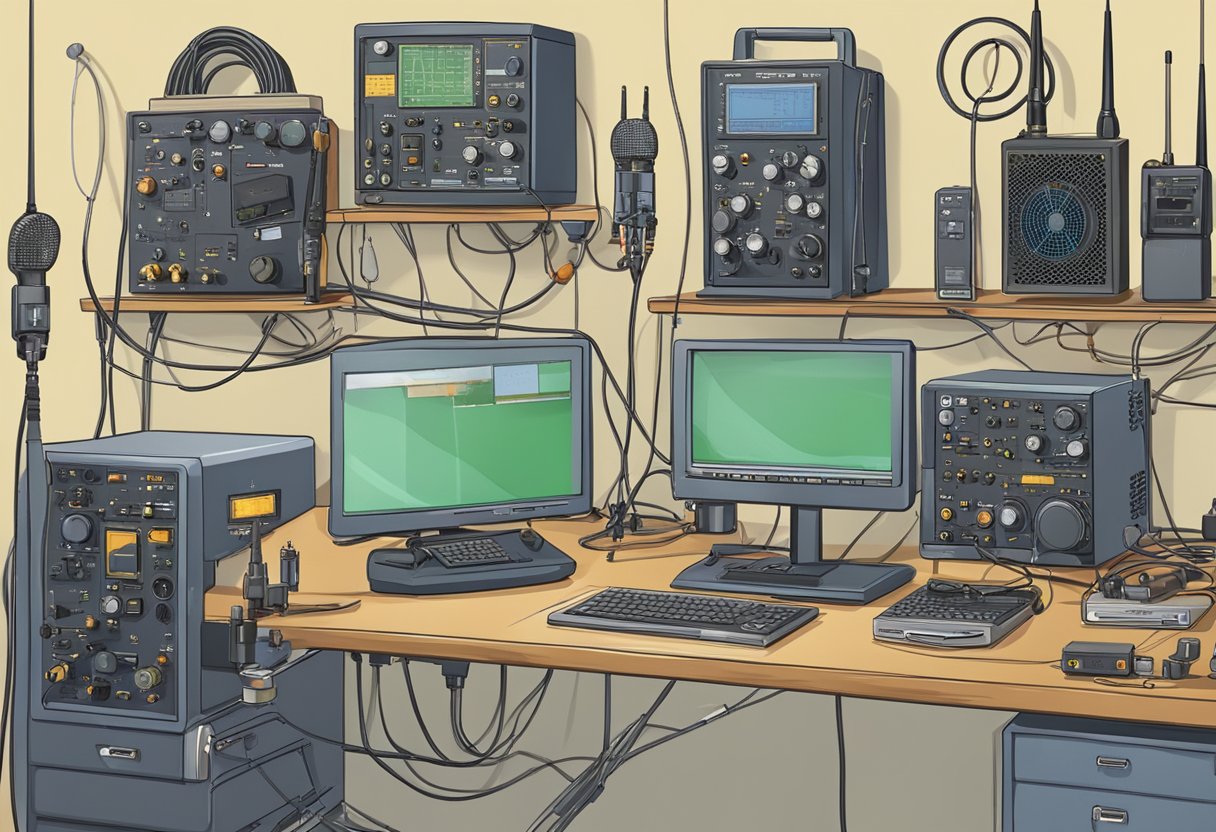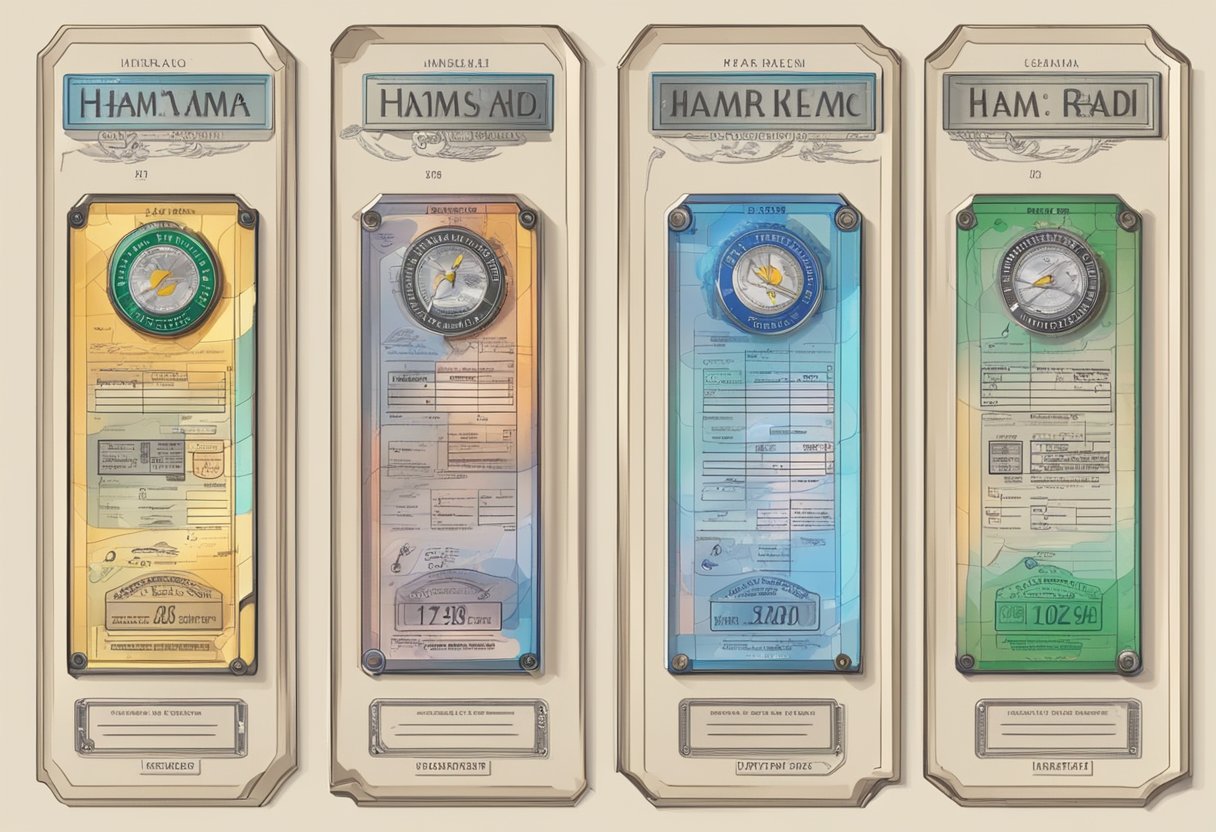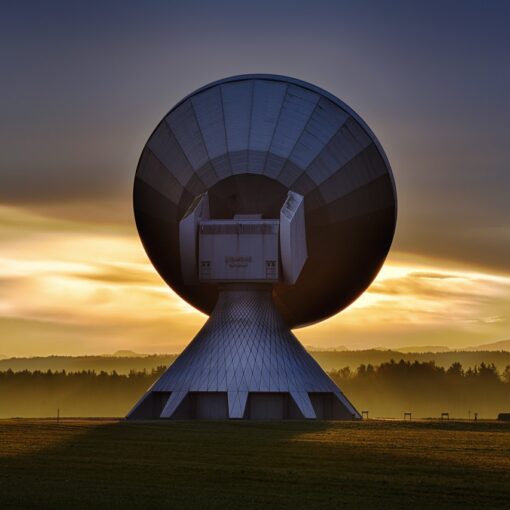Ham radio, or amateur radio, has been a popular hobby amongst enthusiasts for decades and continues to attract newcomers who are interested in communication technology. The world of ham radio can seem daunting at first, especially for non-techies who may not have a background in electronics or radio communications. However, learning the basics of ham radio is an enjoyable and rewarding experience that can lead to a lifetime of friendships, knowledge, and fun.


In order to get started with ham radio, it is essential to understand the different types of licenses available, the necessary equipment, and ways to connect with other amateur radio operators. There is a wide range of ham radio activities to explore, including digital modes of communication, which have become increasingly popular in recent years. Additionally, ham radio enthusiasts have the opportunity to contribute to their local communities by volunteering their skills during emergencies or participating in public service events.
Key Takeaways
- Ham radio is an accessible hobby for individuals with a variety of technical backgrounds, including non-techies.
- Acquiring a ham radio license, understanding equipment essentials, and connecting with others are critical steps for newcomers.
- Exploring various activities and digital modes of communication can provide a dynamic and fulfilling ham radio experience.
Understanding Ham Radio
https://www.youtube.com/watch?v=R5WvZixKA0o&embed=true
Ham radio, also known as amateur radio, is a popular hobby and communication method that utilizes radio waves to communicate with other radio enthusiasts around the world. Radio waves, which are part of the electromagnetic spectrum, facilitate the exchange of information by varying the frequency and amplitude of the transmitted signals.
The ham radio community is known for its camaraderie and willingness to share knowledge with new enthusiasts. This is particularly important for non-technical individuals who may be intimidated by the sheer breadth of information surrounding this topic. Hobbyists can collaborate on various projects, engage in friendly competitions, or even provide vital communication services during emergencies or natural disasters.
Getting started with ham radio involves obtaining a license from the appropriate regulatory authority, such as the Federal Communications Commission (FCC) in the United States. The licensing process typically requires passing an exam that tests an individual’s understanding of radio theory, regulations, and operating procedures. Licenses come in different classes, each offering different privileges regarding the frequency bands and power levels that can be used.
Once licensed, a ham radio operator has access to a vast array of frequency bands that span across the radio spectrum. These frequencies are designated for amateur radio use and can be utilized for various communication modes such as Morse code, voice (SSB, FM, and AM), and digital modes like RTTY, PSK, and FT8. The choice of frequencies and communication modes often depends on the operator’s interests, available equipment, and atmospheric conditions.
In conclusion, understanding ham radio is a process that involves learning about radio waves, frequency bands, and communication modes. By obtaining a license and collaborating with other amateur radio enthusiasts, non-technical individuals can quickly grasp the fundamentals of this fascinating hobby. Everyone – whether technically inclined or not – can enjoy the world of amateur radio and use it to connect with people from all corners of the globe.
Types of Licenses


Technician Class
The Technician class license is the entry-level option for most new ham radio operators. This class focuses on providing a basic understanding of radio theory, regulations, and operating practices. To earn the Technician license, candidates must pass a 35-question examination covering these topics1. As a Technician, you have access to a limited range of frequencies and operating modes. Nevertheless, this license offers a great starting point for beginners to get acquainted with ham radio communication and operation.
General Class
After obtaining the Technician license, you may choose to upgrade to the General class license. The General class allows operators to access a wider range of frequencies and communication modes. To achieve this level, you must pass another examination on more advanced radio theory, antenna design, and safety procedures. With a General class license, operators can explore long-distance communication (DX), participate in emergency communication networks, and enjoy more sophisticated aspects of ham radio operation.
Extra Class
The Extra class license is the highest level of certification offered in ham radio. Holders of this license have demonstrated advanced knowledge in radio theory, electronics, and operating practices. To obtain this prestigious status, you must pass a 50-question examination covering advanced topics, such as complex antenna design, radio wave propagation, and circuit analysis. Extra class license holders have the broadest access to frequencies and modes of communication, as well as the coveted shorter call signs for easier on-air identification. The Extra class license is perfect for those who want to push their technical and operating abilities to the highest level possible in the amateur radio hobby.
Footnotes
Equipment Essentials


Handheld Radios
Handheld radios are portable, compact devices that enable communication between fellow ham radio operators. They are typically used for local and regional communication, making them a popular choice for new operators. These radios operate within the Very High Frequency (VHF) and Ultra High Frequency (UHF) ranges, providing clear, short-range connections.
When selecting a handheld radio, consider factors such as antenna length, battery life, and ease of use. Additionally, many handheld radios now come with features such as digital signal processing and dual-band capabilities, allowing you to communicate on both VHF and UHF bands simultaneously.
Digital Radios
Digital radios have gained popularity in recent years, as they offer improved audio quality, better signal strength, and a variety of advanced features. These radios use digital signals to transmit data, allowing for clearer and more efficient communication compared to their analog counterparts. Digital radios operate on HF bands, granting users access to longer-range and worldwide communication.
There are multiple digital communication modes available, such as Digital Mobile Radio (DMR), System Fusion, and D-STAR. When choosing a digital radio, consider factors like supported modes, compatibility, and required additional equipment, such as interface modems or software for specific modes.
In conclusion, both handheld and digital radios serve as essential equipment for any amateur radio operator. Whether you’re a non-techie looking to explore the world of communication or an experienced ham seeking to upgrade your gear, keep these considerations in mind to make informed decisions about purchasing and operating your radios.
Connecting with Others
Making Friends
One of the main benefits of ham radio is the ability to connect with people around the world, making friends and sharing interests. To start reaching out to fellow ham radio operators, consider joining a net. A net is a scheduled on-air gathering of radio operators who share a specific interest or topic. By listening and participating in nets, you can make connections, learn from others, and improve your communication skills.
When you want to connect with someone, you’ll need to announce your call sign. A good practice when announcing your call sign along with that of another ham is to put yourself last, as in “KI5LMR, this is KI5WTR” if your call sign was KI5WTR.
Building Networks
Ham radio is not only about making friends but also about building networks and becoming part of a worldwide community. Participating in nets and sharing your experiences can help you grow your network and establish yourself within the ham radio community. You might even find yourself collaborating on projects, attending local meetups, and participating in emergency communication drills.
One popular way to connect with other operators is through EchoLink. EchoLink is an internet-based system that allows ham radio operators to use Voice over IP (VoIP) technology to enhance their communication experience. By using EchoLink, you can reach other hams worldwide, even when radio propagation conditions are not favorable.
Remember, the key to successfully connecting with others is to be confident, knowledgeable, and engage in clear communication. As you continue to explore the exciting world of ham radio, you’ll undoubtedly make new friends, strengthen your network, and acquire a wealth of knowledge that you can share with others.
Exploring Ham Radio Activities
Participating in Field Day
Field Day is an annual event where ham radio operators gather to set up temporary stations and make contacts with other operators. Many operators enjoy the challenge of setting up their equipment in a variety of locations, such as public parks, private land, or even remote places away from the city. This event is great for beginners and experienced operators alike, as it offers the opportunity to learn from others, practice communication skills, and work as a team.
Logging Activities
Logging is an essential aspect of ham radio, as it helps track the progress of an operator’s contacts and achievements. Many operators use software like QRZ to record their contacts and share information with other users. Logging also allows operators to apply for various awards and certificates that showcase their expertise and dedication to the hobby.
Experimenting with Radio Waves
Ham radio isn’t just about talking to other people; it’s also about the fascinating world of radio waves and how they interact with the environment. Experimenting with radio waves can involve building antennas, testing different frequencies, and learning how to overcome challenges such as interference or weak signals. The knowledge gained from these experiments can lead to better performance on the air and a deeper understanding of the science behind radio communication.
DXing
One exciting aspect of ham radio is the practice of DXing, which involves making long-distance contacts with other operators across the world. DXing can be a thrilling adventure, as operators often work with limited resources and challenging conditions to establish contact with other countries. This activity can help operators improve their communication skills, learn about other cultures, and develop a strong sense of community within the ham radio world. Some popular activities within DXing include participating in contests and chasing rare stations or special event call signs.
Talking via Satellites
Another fascinating aspect of ham radio involves communicating with other operators through satellites. There are various satellites in orbit dedicated to amateur radio communication, allowing operators to relay their signals over long distances and reach places that might otherwise be unreachable due to geographical limitations. Utilizing satellites can be challenging, as it requires specialized equipment, knowledge of satellite orbits, and precise timing. However, mastering this skill can open up a whole new world of communication possibilities for ham radio enthusiasts.
Digital Modes of Communication
Ham radio offers a wide range of digital modes for communication, making it accessible and enjoyable for both tech-savvy individuals and non-techies alike. In this section, we will delve into three popular digital modes for amateur radio operators: DMR, Packet, and Winlink.
DMR
DMR (Digital Mobile Radio) is a popular digital voice and data communication protocol that allows ham radio enthusiasts to communicate with one another more efficiently. DMR utilizes Time Division Multiple Access (TDMA) technology, which enables simultaneous two-way communication on a single channel.
Pros of using DMR include:
- Clear audio quality due to digitalization
- Extended range compared to traditional analog methods
- Availability of advanced features such as text messaging and GPS
To start using DMR, one would need a DMR-compatible radio and access to a DMR repeater or hotspot.
Packet
Packet radio is a digital mode of communication that sends data in small packets through radio waves. It is closely associated with the Automatic Packet Reporting System (APRS) and enables operators to exchange text messages, emails, images, and other data.
Some strengths of packet radio are:
- Ability to send and receive data in addition to voice communication
- Error-checking capabilities that ensure information accuracy
- Wide range of applications, such as emergency communications and remote control
To get started with packet radio, an operator would typically need a radio with packet capability, a Terminal Node Controller (TNC), and a computer.
Winlink
Winlink is a global radio messaging system that provides email services to radio operators worldwide. It can function with or without the internet, making it a crucial communication tool in emergency situations and remote locations.
Winlink boasts features such as:
- Access to email and data transfer
- Support for various digital modes, such as PACTOR, WINMOR, and ARDOP
- Automatic routing and tracking capabilities
To utilize Winlink, a user would require a radio, sound card interface or modem, and a computer with Winlink software.
The digital modes mentioned above offer distinct advantages for ham radio operators, catering to different preferences and situations. Explore these modes and find the one that suits your needs best.
Ham Radio and The Internet
The integration of ham radio and the internet has significantly enhanced communication capabilities in the amateur radio community. With internet-based modes, users can effectively bridge geographical barriers and expand their reach across the world.
One remarkable illustration of this integration is EchoLink. EchoLink is a software application that enables ham radio operators to connect their radio equipment to the internet. By doing so, they can make long-distance connections that would otherwise be impossible with traditional radio frequencies. The software also allows users to communicate through repeaters, which are helpful for overcoming signal limitations.
Furthermore, the internet offers an abundance of resources for non-techies interested in ham radio. HAM Radio for Non-Techies – YouTube is an excellent example of an online platform that provides a wealth of learning material for amateurs starting their journey in ham radio. This YouTube channel presents an array of video guides, tutorials, and demonstrations to help novices understand technical aspects, equipment setup, and operations.
Incorporating internet-based modes in ham radio communication allows for broader contact with fellow operators and emergency communication systems. These advancements contribute to a more versatile and resilient network that can reach beyond traditional radio limitations, making amateur radio communication a continually evolving and engaging hobby for non-techies.
Volunteering and Giving Back
Working with Red Cross
Ham radio operators can make a difference in their communities by working with organizations like the Red Cross. By offering their communication skills and expertise, they can assist in disaster relief efforts and other emergency situations. Many hams participate in the Amateur Radio Emergency Service (ARES) program, which provides needed communication services in times of need.
Becoming a Volunteer Examiner
Another way ham radio operators can give back is by becoming a Volunteer Examiner. Volunteer Examiners help new and aspiring hams earn their licenses by administering exams and welcoming newcomers to the hobby. In addition to sharing their knowledge and experience, Volunteer Examiners also help bolster a nationwide emergency communications network.
Participating in Skywarn
Ham radio operators can also volunteer with Skywarn, a program organized by the National Weather Service to report severe weather events. By providing real-time, ground-level reports on storms, hams aid in informing accurate forecasts and storm tracking, enabling others to take appropriate precautions. Participation in Skywarn is an opportunity for ham radio enthusiasts to use their skills to help protect communities from severe weather threats.
These are just a few examples of how ham radio operators contribute to their communities and give back to society. Through volunteering efforts with organizations like the Red Cross, ARES, Skywarn, and as Volunteer Examiners, amateur radio enthusiasts can make a tangible difference in times of need.
Frequently Asked Questions
What are some basic tips for operating a ham radio?
When operating a ham radio, it’s important to follow proper etiquette and techniques. Always press the PTT (Push-To-Talk) button and wait for about half a second before speaking, especially if you’re communicating through a repeater, as it takes some time for the repeater to “catch up” with you ^(source). Keep the microphone at a reasonable distance from your mouth and speak clearly.
Which are some simple projects for ham radio enthusiasts?
Ham radio enthusiasts can try various projects, such as building antennas, setting up a portable station, or experimenting with digital communication modes. These projects help beginners become more familiar with the hobby and improve their skills.
What are common abbreviations used in ham radio?
Some common ham radio abbreviations include QSO (communication between two stations), QRP (low power operation), and CQ (calling any station). These abbreviations are part of the Q Code, a set of standardized messages for radio communication.
How does one predict propagation in ham radio?
Predicting propagation in ham radio involves understanding the factors that affect radio waves, such as the sunspot cycle, ionospheric conditions, and time of day. Various tools and websites can help predict propagation, allowing operators to plan their activities and maximize their chances of successful communication.
What resources are available for ham radio beginners?
A variety of resources is available for ham radio beginners, including websites, books, online forums, and YouTube channels. For example, the HAM Radio for Non-Techies YouTube channel provides informative videos and tutorials aimed at newcomers to the hobby.
What are the best affordable ham radios for beginners?
Several affordable ham radios are suitable for beginners, including the popular Baofeng UV-5R handheld radio. When choosing a ham radio, consider your budget, intended use, and local regulations. Additionally, research reviews and recommendations to find the best fit for your needs.





